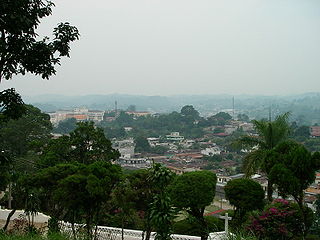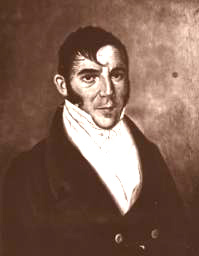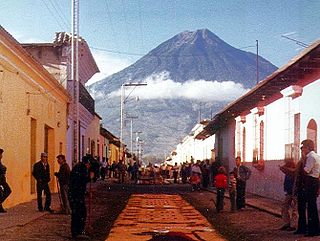Related Research Articles

Guatemala City, officially New Guatemala of Assumption, known locally as Guate, is the capital and largest city of Guatemala, and the most populous urban area in Central America. The city is located in the south-central part of the country, nestled in a mountain valley called Valle de la Ermita. The city is the capital of the Municipality of Guatemala and of the Guatemala Department.

Cobán, fully Santo Domingo de Cobán, is the capital of the department of Alta Verapaz in central Guatemala. It also serves as the administrative center for the surrounding Cobán municipality. It is located 219 km from Guatemala City.

Antigua Guatemala, commonly known as Antigua or La Antigua, is a city in the central highlands of Guatemala. The city was the capital of the Captaincy General of Guatemala from 1543 through 1773, with much of its Baroque-influenced architecture and layout dating from that period. These characteristics had it designated as a UNESCO World Heritage Site in 1979. Antigua Guatemala serves as the capital of the homonymous municipality and the Sacatepéquez Department.

Quiché is a department of Guatemala. It is in the heartland of the K'iche' (Quiché) people, to the north-west of Guatemala City. The capital is Santa Cruz del Quiché. The word K'iche comes from the language of the same name, which means "many trees".

José Rafael Carrera y Turcios was the president of Guatemala from 1844 to 1848 and from 1851 until his death in 1865, after being appointed President for life in 1854. During his military career and presidency, new nations in Central America were facing numerous problems: William Walker's invasions, liberal attempts to overthrow the Catholic Church and aristocrats' power, the Civil War in the United States, Mayan uprising in the east, Belize boundary dispute with the United Kingdom, and the wars in Mexico under Benito Juárez. This led to a rise of caudillos, a term that refers to charismatic populist leaders among the indigenous people.

Chichicastenango, also known as Santo Tomás Chichicastenango, is a town, with a population of 71,394, and the municipal seat for the surrounding municipality of the same name in the El Quiché department of Guatemala. It is located in a mountainous region about 140 km (87 mi) northwest of Guatemala City, at an altitude of 1,965 m (6,447 ft). The Spanish conquistadors gave the town its name from the Nahuatl name used by their allied soldiers from Tlaxcala: Tzitzicaztenanco, or City of Nettles. Its original name was Chaviar.
Latin America contains approximately 17.5% of the world's Quakers. Latin American Friends are concentrated in Bolivia and Central America. Most of these Friends are evangelical and are affiliated with Evangelical Friends Church International. Friends World Committee for Consultation organizes among them through the Comité de Amigos Latinoamericanos CoAL del Comité Mundial de Consulta de Los Amigos CMCA FWCC.

Mixco is a city and municipality in the Guatemala department of Guatemala. It is next to the main Guatemala City municipality and has become part of the Guatemala City Metropolitan Area. Most of Mixco is separated from the city by canyons, for which a multitude of bridges have been created. Ciudad San Cristóbal, one of Guatemala's largest cities, is located in this municipality. It is the second largest city in Guatemala Department, after Guatemala City, with a population of 465,773.

Earthquake Baroque or Seismic Baroque is a style of Baroque architecture found in the Philippines and Guatemala, which suffered destructive earthquakes during the 17th century and 18th century, where large public buildings, such as churches, were rebuilt in a Baroque style during the Spanish Colonial periods in those countries.

The Captaincy General of Guatemala, also known as the Kingdom of Guatemala, was an administrative division of the Spanish Empire, under the viceroyalty of New Spain in Central America, including the present-day nations of Costa Rica, Nicaragua, Honduras, El Salvador, and Guatemala, and the Mexican state of Chiapas. The governor-captain general was also president of the Royal Audiencia of Guatemala, the superior court.

The Catholic Church in Guatemala is part of the worldwide Catholic Church, under spiritual leadership of the Pope, Curia in Rome and the Episcopal Conference of Guatemala. There are approximately 7.7 million Catholics in Guatemala, which is about 45% of the total population of 17.1 million citizens.

Christianity has dominated Guatemalan society since its Spanish colonial rule, but the nature of Christian practice in the country has changed in recent decades.

José Felipe Mariano Gálvez was a jurist and Liberal politician in Guatemala. For two consecutive terms from August 28, 1831, to March 3, 1838, he was chief of state of the State of Guatemala, within the Federal Republic of Central America. In 1836, he was elected a member of the American Philosophical Society.

The 1976 Guatemala earthquake struck on February 4 at 03:01:43 local time with a moment magnitude of 7.5. The shock was centered on the Motagua Fault, about 160 km northeast of Guatemala City at a depth of 5 kilometers (3.1 mi) near the town of Los Amates in the department of Izabal.

Guatemala, officially the Republic of Guatemala, is a country in Central America. It is bordered to the north and west by Mexico; to the northeast by Belize and the Caribbean; to the east by Honduras; to the southeast by El Salvador and to the south by the Pacific Ocean. With an estimated population of around 17.6 million, Guatemala is the most populous country in Central America and the 11th most populous country in the Americas. It is a representative democracy with its capital and largest city being Nueva Guatemala de la Asunción, also known as Guatemala City, the most populous city in Central America.

Holy Week in Guatemala is celebrated with street expressions of faith, called processions, usually organized by a "hermandad". Each procession of Holy Week has processional floats and steps, which are often religious images of the Passion of Christ, or Marian images, although there are exceptions, like the allegorical steps of saints.

The Church of Jesus Christ of Latter-day Saints in Guatemala refers to the Church of Jesus Christ of Latter-day Saints and its members in Guatemala. The first convert in Guatemala was baptized in 1948. As of December 31, 2021, there were 284,780 members in 436 congregations in Guatemala. Guatemala ranks as having the 4th most members of the LDS Church in North America and 8th worldwide.

The 1917 Guatemala earthquakes were a sequence of tremors that lasted from 17 November 1917 through 24 January 1918. They gradually increased in intensity until they almost completely destroyed Guatemala City and severely damaged the ruins in Antigua Guatemala that had survived the 1773 Guatemala earthquakes.
The Convention of Baptist Churches in Guatemala is a Baptist Christian denomination in Guatemala. It is affiliated with the Baptist World Alliance. The headquarters is in Guatemala City.